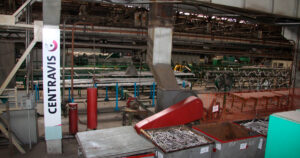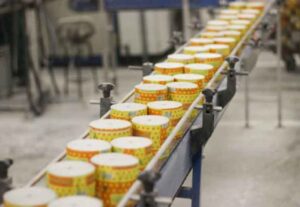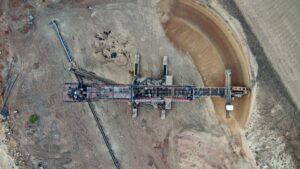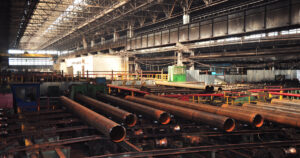
Centravis Production Ukraine PJSC (Centravis Production Ukraine), part of Centravis Ltd holding, has invested more than UAH 50 mln in its Uzhgorod branch, officially opened in late February and plans further expansion.
According to the company’s Wednesday press release, the new production facility in Uzhgorod specializes in tool pipes for the world’s leading car brands (Volkswagen, Audi, BMW, and Chevrolet).
The total investment amounted to more than UAH 50 million, about 100 employees work at the new plant, but this year it is planned to expand and build the second stage.
“Our team has been nurturing the idea of a new plant for a long time, but the war became the driver of this process and we quickly moved from design to action. The overall goal is to strengthen our position in the global market and strengthen the sustainability of the company,” explains Centravis CEO Yuri Atanasov, who is quoted by the press service.
According to his words, the management was considering different locations for new production – in Ukraine and abroad, but in the end it was decided to start the work in Uzhgorod. Main reasons – desire to invest in their country during hard war time, create jobs for Ukrainian employees and proximity to the western border, which in its turn would help to deliver orders to “Centravis” customers even faster.
Head of production in Uzhgorod Sergey Shadsky noted that this is only the first phase of the plant, and immediately after the opening work on its expansion began. Production in Uzhgorod will not depend on cold production in Nikopol, because the first deformation run can be carried out on the relocated mill KhPT-55 cold rolling directly on the production site in Uzhgorod, but the branch will still receive semi-finished products from the hot production of the main site in Nikopol.
“We plan to complete the works on the second stage of construction by summer, and we are already planning the third stage. We have ambitious plans. We want Uzhgorod to be known as one of the world centers for the production of pipes for cars, “- summarized the head of the new production “Centravis” in Uzhgorod.
As it was reported, official opening of new Centravis’s production site of specialized production of instrument tubes for cars was held in Uzhgorod on February 28.
Also reported that the holding Centravis Ltd re-registered its parent company in Switzerland, replacing the Cypriot location, which is expected to help improve credit rating and attract longer and cheaper money to develop production in Ukraine.
“Centravis was founded in 2000 and is among the ten largest manufacturers of seamless stainless steel tubes in the world. Its main production capacities are located in Nikopol (Dnipropetrovsk region). In 2022 the company has realized a number of large-scale orders for such world companies as Benteler Automotive, LINSTER Edelstahlhandel, Rohr Mertel, Buhlmann Group, Webco, MRC. The company employs more than 1400 people.
Holding Centravis Ltd. was created on the base of Nikopol Stainless Tube Works CJSC, service and trade companies Industrial and Commercial Enterprise Yuvis Ltd. Its shareholders are members of the Atanasov family.
Centravis Ltd. owns 100% of shares of Centravis Production Ukraine PJSC.

In January-February, Poninkivska Cardboard and Paper Mill-Ukraine (PCPM-Ukraine, Khmelnytsky region), a major Ukrainian corrugated cardboard producer, increased its output of corrugated packaging by almost 30% compared to the same period in 2022, to 12.41 million square meters.
According to Ukrpapir Association statistics provided to Interfax-Ukraine, the mill is still among the top three producers of corrugated packaging after Kyiv Cardboard and Paper Mill and Trypillia Packaging Mill, and is still the fastest growing.
As reported, according to data collected by the association from the industry’s major enterprises, a total of 78.5 million square meters of cardboard boxes were produced in Ukraine over two months, down only 0.6% from the almost pre-war January-February period last year.
According to UkrPapir, Poninkivska KBF-Ukraine produced a total of UAH 417.44 million worth of products in two months, up 27.9% year-on-year.
In physical terms, paper production also increased by 21.6% to 107 tons and production of containerboard by 12.4% to 11.54 thousand tons.
Poninkivske Mill (formerly Poninkivske Cardboard and Paper Mill), once the largest producer of school notebooks, now has one main production line – paper and cardboard, producing mainly corrugated cardboard and corrugated packaging, as well as wrapping and waste paper.
The mill is part of the United Cardboard Company-Ukraine (UCC, Lutsk), whose production assets include, among others, Lutsk KBF-Ukraine (Volyn region), which produced 8.8 thousand tons of cardboard in January-February (according to Ukrpapir), up 18.7%, including 5.76 thousand tons of containerboard (+8.2%).
As reported, in 2022, Poninkivska KBF-Ukraine produced products worth UAH 2 billion 446 million, up 6.5% year-on-year.

In January-February of the current year Kokhavynska Paper Factory (KPF, Lviv region), which produces hygienic paper products (TM “Kokhavinka”), increased its production volume by 47% in comparison with the same period of 2022 – up to 183,7 million UAH.
According to statistical data of UkrPapir Association, provided to Interfax-Ukraine Agency, the production of paper-base for sanitary products in physical terms increased by 4.7% – to 6.8 thousand tons.
In the meantime, production of toilet paper rolls increased by 21.6% up to 22.56 million pieces, so CBF confidently retains its second place in output after Kyiv PMC (32.25 million pieces), which in January-February reduced output by 46.2%.
In total, according to the Association, in January-February, production of toilet paper in Ukraine by major manufacturers of the industry decreased by a quarter compared to January-February 2022 – almost prewar – up to 80.78 million pieces.
Kokhavinsk Paper Mill, which has been in operation since 1939, produces base paper for sanitary and hygienic goods, as well as toilet paper and paper towels. The capacity of the paper machines is 19 thousand tons per year, the processing equipment is 90 million rolls per year.
The factory has barely stopped production since early 2022.
As reported, last year KBF produced 975.3 million UAH – 44.8% more than the year before.

In February of this year, Marganets Mining and Processing Plant (MMPP, Dnipropetrovs’k region) reduced its production volumes, in particular due to threats of shelling by the Russian occupiers, difficult weather conditions and lack of staff.
According to the company, February was quite difficult for MMPP: the work of all departments and divisions was affected by the difficult mining and geological conditions in the mines of the plant, weather conditions that significantly affected the operation of the Hrushevsky open pit, as well as the threat of artillery shelling by the Russian army from the temporarily occupied Enerhodar.
Therefore, the total production of crude manganese ore at MMPP amounted to 34,783 thousand tons, which is 4,816.7 tons less than the February target (87.8% of the plan), as mines No. 9/10 and 14/15 failed to meet their targets.
The only underground mining shop that met its targets was mine No. 3/5, which produced 206 tons above the plan, totaling 4,006 thousand tons of ore (105.4% of the plan).
Mine No. 9/10 fulfilled the February plan by 69.8%, producing 9207.3 tons of ore.
“These figures were affected not only by poor mining and geological conditions, frequent stops for manual work, crossing of drifts, but also by a catastrophic shortage of staff, who were mostly on sick leave,” the company said in a statement.
In turn, Mine No. 9/10 managed to meet its sinking plan by 116.9%, meaning that the tunnellers of this shop sank 76 linear meters of mine workings, even though they were manually sinking in the 15th southwestern drift on the last working days of February, the company said.
At the same time, it is noted that at the mine No. 14/15, there was a certain destabilization of the moral climate of the shop workers due to staff shortages, frequent equipment breakdowns and emergency downtime. As a result, the ore production backlog in February amounted to 1,030 tons (95.4% of the plan), and since the beginning of 2023, the shop has fallen behind by 2,378 tons. In total, the division’s miners mined 21.570 thousand tons of ore in February.
In February, Hrushevsky open pit did not mine crude manganese ore and a number of other operations. At the same time, the plan for conveyor stripping was fulfilled by 136.7 thousand cubic meters (109.4%), as well as the plan for re-excavation of rock mass by the non-transportation method by 52 thousand cubic meters.
For its part, Pokrovsky GOK (PGOK, formerly Ordzhonikidze GOK, Dnipropetrovska oblast) reports that the company is preparing to launch operations in April, having been idle since December 1, 2022, and that its concentrators have been shut down since October 1, 2022 (they do not produce concentrate) due to a shortage of electricity.
PGOK is the largest open-pit manganese ore producer in Ukraine. Four Cypriot companies – Profetis Enterprises Limited, Exseed Investmens Limited, Clemente Enterprises Limited and Alexton Holdings Limited (all from Cyprus) – own 24.3024% of the company’s shares.
As reported, in 2022, MMPP reduced its production of manganese concentrate by 41.2% year-on-year to 324 thousand tons.
In 2021, MMPP produced 551.43 thousand tons of concentrate (at the level of 2020).
MMPP is developing the eastern part of the Nikopol manganese ore deposit (Hrushevsko-Basansky area). The plant comprises four operating mines, including one under construction, one open pit mine – Hrushevsky – and a concentrator.
According to the company’s data as of the end of June 2022, the largest shareholders of the company are Couttenmax Holdings Limited, Mosfilia Investments Limited and Humax Enterprises Limited, which own 23.89% of the company each, as well as Fianex Holdings Limited (all Cyprus), which owns 24% of the shares.
The authorized capital of MMPP is UAH 366.625 million, with a share price of UAH 0.25.

Beer production in Ukraine (except non-alcoholic with alcohol content up to 0.5% vol.) in January-February 2023 decreased by 8.9% compared to the first two months of 2022 – up to 16.2 million dal, according to the website of the brewers’ organization Ukrpivo on Friday.
At that it is specified that in January this year the lag in the production of this drink compared to January 2022 was 15.2%.
In turn, in January-February 2023, Ukraine produced 28.9 thousand tons of malt, which is 5.7% less than the first two months of last year.
As it was reported, beer production in Ukraine in 2022 dropped by 27.9% compared to 2021 – up to 122.8 million dal.
By the end of 2022 the brewing industry has partially recovered after a 50% drop in production of this drink in the first quarter due to the Russian invasion and the shutdown of some breweries. Thus, in the first four months of 2022 the decline was 42.8% compared to the same period of 2021, January-May – 36.4%, January-June – 32%, January-July and January-August – 31.6% each, January-September – 30.5%, January-October – 28.6%, January-November – 28.1%, the year before – 27.9%.

In 2022, Ukrtruboprom has reduced the production of pipes by 37.9% compared to the previous year – down to 449.7 thousand tons.
According to the association, all the plants showed negative dynamics last year. “Interpipe Niko Tube and Trubostal decreased their production of seamless pipes by 31.1% and 61.6%, respectively, Centravis – stainless pipes by 38.3%, Interpipe NMTZ – electric-welded pipes by 67.1%. The production of tubes at Oskar fell by 20%, and only Ukrtruboizol, an IPO, reached the level of production the year before last.
At the same time it is reminded that Dnepropetrovsk pipe plant is idle and is in the state of liquidation.
Director General of Ukrtruboprom Association Georgiy Polskiy noted that at the end of winter last year, after the full-scale invasion of Russian troops into Ukraine, virtually the entire pipe industry came to a halt. Nevertheless, later on the plants managed to partially restore production, and in the summer to have a stable load, although we cannot speak about pre-war volumes.
“A new test for the industry was the enemy strikes on the energy infrastructure facilities. The peak of the rocket attacks was in November-December, the country was several times plunged into blackout, pipe plants were limited by power supply and could not work rhythmically. As a result the production of pipes by the end of the year dropped below April 2022. On the whole, the last year output of pipes in Ukraine went down by 38%,” says the head of the Association.
He says that break up of the traditional logistic schemes, in particular, blocking of the Ukrainian seaports at the Black Sea, had an extremely negative influence on the industry. As a result, the companies used longer routes for exporting their products through Western border crossings and European seaports. This led to a rise in logistics costs by 2-3 times and hit the cost of Ukrainian products.
“Since autumn, pipe companies have had another challenge – export of scrap metal. From October to December the volume of exports reached about 25 thousand tons, increasing the deficit in the domestic market. At the beginning of 2023 the problem became catastrophic, because only in two months of this year export of scrap metal has already reached 23 thousand tons. This threatens the stable work of Ukrainian pipe enterprises”, – said Polskyy.
As reported, Ukraine in 2021 increased the production of pipes by 15.1% compared with the previous year – up to 980.7 thousand tons, including enterprises “Ukrtruboprom” increased their production by 32.6% – to 710.5 tons.